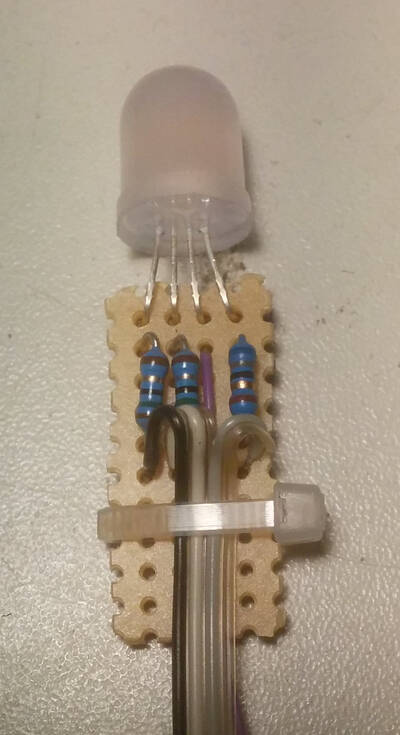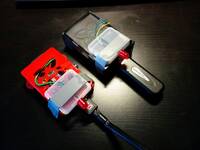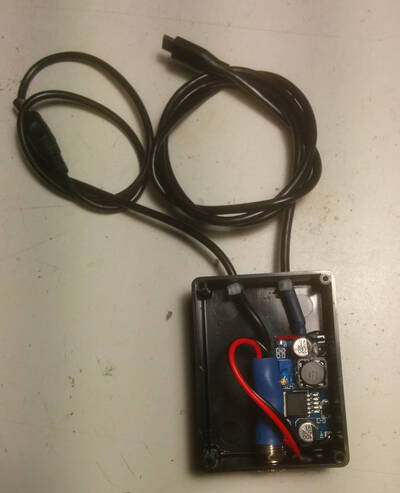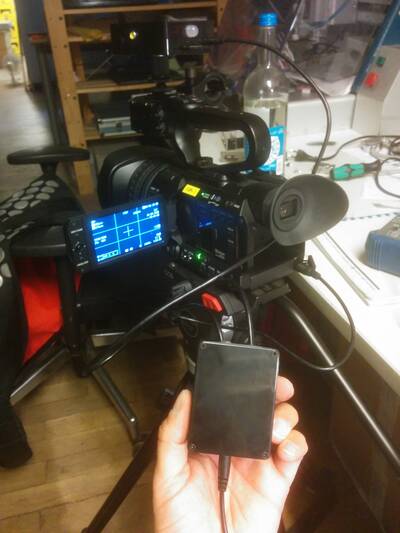**This is an old revision of the document!**
tallycom
- name:
- tallycom
- project-owner:
- project-members:
- git-url:
- https://github.com/voc/voctomix/tree/voctopanel/example-scripts/voctolight
- project-description:
- This is a tallylight and intercom solution designed to be used with voctomix
- project-status:
- running
Poll
- Headsets mit button sind schwer zu finden / teuer
- Schalter an Stativ muss jedes mal fest gemacht werden
- Attach the button fixed to the tripod handle (endcap to leave room for zoom buttons on handle itself?) and connect it to the tally using connectors (something robust). Connecting button to the tally is a problem for each “solution”. (Bix)
- Fussschalter brauch platz im case
TODOs
- Debug voctolight: does not light up when camera is used as second source in composite_mode picture_in_picture
- voctolight: reconnect automatically when voctocore is restared
- find better headsets (Im besten Fall geschloßen, mit stark gerichtetem Mikrophon und nur einer Ohrmuschel.)
- find PTT buttons to be mounted on the tripod handle
Feature Requests
- [Thorti] Unterschiedliche Configs für Tallycom (Kamera vs. Mischer/VOC-Office). Kamera= LED leuchtet, wenn Cam in Verwendung; Mixer/Office= LED leuchtet, wenn jemand im Channel spricht
- [Thorti] Möglichkeit für SaalAV-Mensch in mehreren Räumen gleichzeitig zu hören, aber nur in einem zu sprechen, um z.B. im Kanal zwischen Kamera/Mischer zu agieren und gleichzeitig im VOC-Channel erreichbar zu sein.
- [Thorti] Beltbak-Lösung für mobil mit WLAN (Halterung mit Gürtelklammer?). Stromversorgung via Powerbank. == Hardware
The current hardware is a Raspberry Pi 3, we need evaluate if the intercom part also works stable with an older pi.
- 1x RPI 3 ca 35€
- 1x RPI Case and power suppply + flash mount 10-20€
- 2x USB headset 50€ i.g. https://www.amazon.de/Logitech-960-Stereo-Headset-USB/dp/B0013N474I/
- 1x SD Card ~10€
- 1x LED + Resistor ~2€ (for voctolight)
~ 110€ per room
As alternative an orange pi zero or a nano pi could be used.
The pi can either use its build in wifi with the a wifi provided by the wrt or in case of congress could also use the WPA2-enterprise network. Alternative ethernet can be used
tallycom hardware
prototype alpha
5V from cam power supply for tallycom
Our JVC Cams run on 12V and the Panasonic on 7,5V, therefore we have a step-down converter which provides 5V for the tallycom.
We use a LM2596S DC-DC stepdown converter which has an input voltage range from 1,5 - 35V and can provide up to 3A.
This should work with most other cams to as long as you are not to close to 5V.
Software
voctolight
voctolight is a tellylight part of this project. It listens on the voctomix control channel.
The code is developed in the voctomix repository in the exemple scripts dir.
To get started you need a LED and a resistor. For a normal red LED this would be 330Ohm. Connect the LED with its + to pin 11 and with its - to GND (pin 6)
setup:
ssh voc@10.73.1.15 cd /opt/voctomix/release/example-scripts/voctolight/ vim config.ini sudo systemctl restart voctolight.service
voctocom
To get a audio connection between mixer and camera operator we run a command line mumble client on an rasperrypi 2/3 connected to an USB Headset. For small events, this client connects to a mumble server on the voctogui laptop (or the cube / minion); for bigger event to, a central one running in the server case. Another option would be SIP, but mumble seems to better fit the requirements.
The mixer operator should be able to use push to talk with the keyboard of the mixer or an button in the UI. The camera operators should be able to use the button on the headset for push to talk.
- It could be useful to let the mixer operator to switch the behavior of all clients to open mic.
- operator should be able to listen to all rooms in a common channel
- LED / Notification device for the voc office
- Visual Call: LCD / LED notification for mention / call
Taliepi
c.f. https://github.com/dchote/talkiepi and https://github.com/dchote/talkiepi/tree/master/doc
To change the configuration edit /etc/systemd/system/mumble.service
TODO: check/fix systemd unit – workaround: run manually inside of screen
Does not
Setup
see https://github.com/dchote/talkiepi/tree/master/doc
You need to edit /usr/share/alsa/alsa.conf and change defaults.ctl.card 1 and defaults.pcm.card 1
barnard
This is based on a RasPi 3 and Raspian:
First, create /etc/asound.conf with the following contents:
pcm.!default {
type plug
slave.pcm {
@func getenv
vars [ ALSAPCM ]
default "hw:Headset"
}
}
This will map the Headset to be the default sink/source for audio. This app is written in Go, so we need to install go first, plus a few dependencies written in C, which we pull in via APT. They handle sound and opus encoding respectively:
cd ~ # Get golang for ARM: https://golang.org/dl/ (get go?.?.?.linux-armv6l.tar.gz) tar xvfz go?.?.?.linux-armv6l.tar.gz apt install libopus-dev libopenal-dev export GOPATH=$HOME/gocode
Next, we can build barnard, a gui-based client, that you may want to run in a screen session for production purposes.
~/go/bin/go get github.com/layeh/barnard ~/go/bin/go compile github.com/layeh/barnard #set GOARM=7 to get ARMv7-optimized code strip ~/gocode/gocode/src/github.com/layeh/barnard/main sudo cp ~/gocode/gocode/src/github.com/layeh/barnard/main /usr/local/bin/barnard # (exported.pem is the cert exported from the official mumble client as exported.p12, # and then run thrugh "openssl pkcs12 -in ~/exported.p12 -out ~/exported.pem -nodes" barnard server="mumble.server.example.net:64738" -username=cam1 -insecure=true -certificate=exported.pem
GUI shortcuts: F1 mutes/unmutes on a protocol level, F10 quits.







